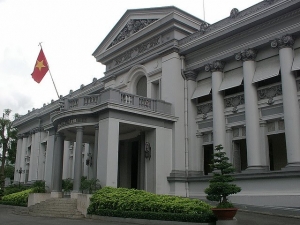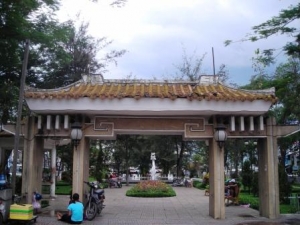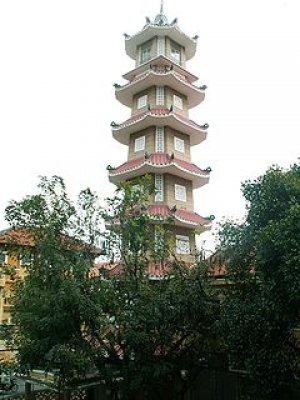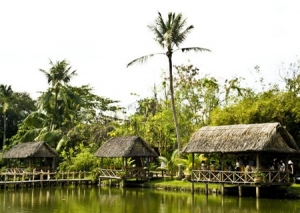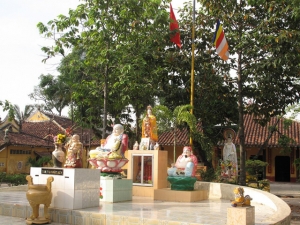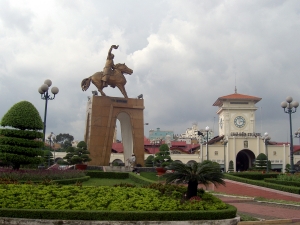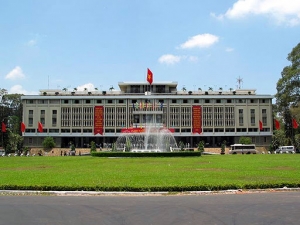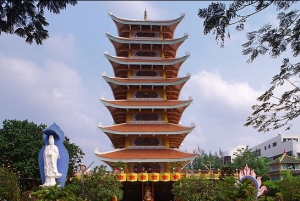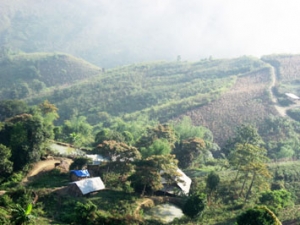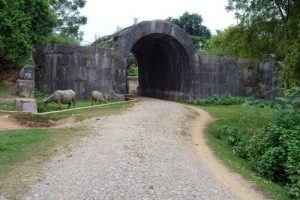
Asia Pacific Travel Team
Visit Hochiminh City's Prominent Museums in Vietnam Tourism
Ly Tu Trong Street - Ho Chi Minh City, Inside the famous Ho Chi Minh City (or Saigon) of Vietnam, there stands a more than 100 year-old building of the “Revolutionary Museum”, which was formerly the palace of the Cochin-china Governor, and then the office of the Imperial Delegate of the King's special envoy.
Visiting the museum, tourists in Vietnam travel will have a thorough understanding of the heroic, historical and heart-rending struggle against the French and American invaders of the Vietnamese in general and Saigon’s people in particular.
Location: No.65 Ly Tu Trong Street, District 1, Ho Chi Minh City (Saigon), Vietnam.
Construction & Formation: The construction of the museum started in 1885 and was completed in 1890 under the design of French architect Alfred Foulhoux, who also designed the Saigon Court. The Municipal Revolutionary Museum was originally intended to display items from Nam Ky (the former name of South Vietnam), but the Governor of Nam Ky enlisted it as his residence. After that, the building became the residence of Japanese Governor Minoda. It was also the office of the Nam Bo Provisional Administrative Committee (1945) and of the Republic of France High Commissioner. The building was later reconverted into the residence of the Governor of Nam Ky. Until August 1978, the building was finally turned into the Ho Chi Minh City Revolutionary Museum.
Characteristics: Coming here, you can find a number of pictures and exhibits related to the struggle against the French colonialism and the American aggressors to liberate and to protect the City. More importantly, there are images of the General Uprising in the Mau Than Spring (1968) and the historical Ho Chi Minh campaign (1975) to liberate the Country.
Opening time: The museum is opened from 08.00 a.m to 11.30 a.m and 02.00 p.m to 04.30 p.m from Tuesday to Sunday.
War Remnants Museum
Vo Van Tan Street - Ho Chi Minh City
“During the Vietnam War, 3 million Vietnamese were killed, 2 million people injured, 300,000 people missed...”. Visiting the War Remnants Museum, you may know much more about these historical truths from the collections of photos taken by 134 War reporters killed during the Vietnam War, the vestiges of war crimes and aftermaths.
Location: Located at 28 Vo Van Tan Street, District 3, Ho Chi Minh City (Saigon), Vietnam, the museum primarily contains exhibits relating to the American phase of the Vietnam War, and is a major tourist attraction.
Formation: Operated by the Vietnamese Government, the museum was opened in September 1975 as the "The House for Displaying War Crimes of American Imperialism and the Puppet Government (of South Vietnam)". Later it was known as the Museum of American War Crimes, then as the War Crimes Museum until as recently as 1993. Its current name followed liberalization in Vietnam.

Characteristics: The museum contains numerous artifacts, photographs and pictures documenting American war crimes. It comprises a series of eight themed rooms in several buildings, with period military equipment located within a walled yard. The military equipment include a UH-1 "Huey" helicopter, an F-5A fighter, a BLU-82 "Daisy Cutter" bomb, M48 Patton tank, and an A-1 attack bomber. One building reproduces the so-called tiger cages in which the South Vietnamese government housed political prisoners. Other exhibits include graphic photographs, accompanied by short copy in English, Vietnamese and Japanese, covering the effects of Agent Orange and other chemical defoliant sprays, the use of napalm and phosphorus bombs, and atrocities such as the My Lai massacre. Curiosities include a guillotine used by the French and the South Vietnamese to execute prisoners, last in 1960, and three jars of preserved human fetuses. Such artifacts and documents illustrate the killing of civilians, spreading of chemicals, torturing of prisoners and the effects of the war on the north. Planes, tanks, bombs and helicopters are also on display.
For the past over 20 years, Ho Chi Minh City has welcomed millions of foreign visitors, including American tourists visiting the museum.
Opening time: The museum is opened from 08.00 a.m to 11.30 a.m and 02.00 p.m to 04.30 p.m from Tuesday to Sunday.
Joining tours in Vietnam and wishing to know about the whole vivid story of a heroic and historical Saigon, visitors in Vietnam tourism should not miss these museums.
Saigon’s Chinatown- Ho Chi Minh City- Vietnam
In Ho Chi Minh City, there is a small area that many Chinese people have lived for a long time. The area is called China Town which locates in District 5 . Here Chinese people live and support their lives by many of different activities such as opening food stall serving traditional food in Chinese taste, opening shops selling stuffs or clothes. One noticeable characteristic of this area is that there are many stores selling Chinese medicine, especially on Hai Thuong Lan Ong Street.
Selling Chinese Medicine in Saigon's Chinatown
Visiting this area, visitors in Vietnam travel will get the chance to see how Chinese medicine was made and used as well as enjoy the delicious dishes in Chinese taste. Many of the dishes are really good such as noodle, rice and wontons. Visitors can also visit many tourist attractions in the district such as Thien Hau Pagoda on Nguyen Trai street which is the oldest pagoda built by Chinese in the city or the old buildings built based on Chinese structure on Trieu Quang Phuc street. Another place that visitors joining tours in Vietnam cannot miss is Binh Tay Market on Thap Muoi Street. It was built 70 years ago and is always attractive to foreign visitors in Vietnam tourism not only because of its special structure but also its exciting and lively atmosphere.
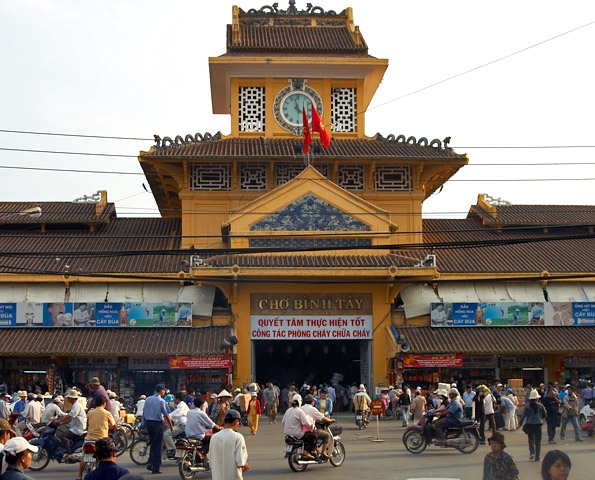
Binh Tay Market- Ho Chi Minh City
China Town or Cho Lon is in district 5 which is near District 1; therefore visitors can easily visit here. From District 1, all you need to do is following Tran Hung Dao street which is named the main route of getting into China Town. This street links the two districts: district 1 and district 5 so it is very convenient for you. If you travel by bus, you can take bus No.1 at Ben Thanh bus station. It will take you go through the China Town. You can choose to get off at any stop you like.
There is no need to China; you still feel how life of Chinese is! It is to visit China town in Ho Chi Minh City if you have a chance.
Xa Loi Pagoda- The First Pagoda of Ho Chi Minh City
Xa Loi Pagoda is a large pagoda and also a relic at the city level of Ho Chi Minh City, lying at the corner of Ba Huyen Thanh Quan Street, District 3 with the huge precinct of 2,500 square kilometers.
The pagoda was started to build on August 5th 1956, following the drawing of the architects Nguyen Van Duong and Do Ba Vinh. And the engineers Du Ngoc Anh and Ho To Thuan were responsible for the construction site. The pagoda building then was finished on May 2nd 1958.
The pagoda was established to worship the Great Buddha and was called with the name "Xa Loi" for short by common people. For that reason, in inaugurating day, the superior Buddhist monk has named it "Xa Loi Pagoda".
This pagoda used to be the main headquarters of the Association of Buddhology of Vietnam from 1951 to 1981. After that, from 1981 to May 1993, it became the headquarters of Buddhist Church of Vietnam (the second office).
Xa Loi Pagoda is the first pagoda of the city which was built in a new style of architecture with an altar above and an amphitheatre staying lower. The design of the pagoda includes a sanctum worshipping Buddha, an amphitheatre, a bell tower, a library, monks' quarters, purifying house, office, a room publishing prayers and bibles, guests' room and an area for travelers staying.
The pagoda worships a huge statue of The Sakyamuni which is made by the School of Fine Arts Bien Hoa. In 1969, the statue was restored with the whole body made of gold and has the shape like today. The sanctum at the upper floor is decorated with a set of big pictures including 15 pictures created by the professor Nguyen Van Long of the School of Fine Arts Gia Dinh. Those pictures have described the life of the Sakyamuni, from newborn time to the time of entering Nirvana.

Xa Loi Pagoda- Ho Chi Minh City
The bell tower Xa Loi was opened in 1961. It is 32 metres high and has 7 floors. This is the highest bell tower of Vietnam. Inside the tower, on the highest floor, there hangs a great bell which weighs 2 tones and was casted according to the model of the bell in Thien Mu Pagoda in Hue.
You, tourists in Vietnam travel, should not miss to visit Xa Loi Pagoda when you are in Ho Chi Minh City. The pagoda is opened daily from 7 to 11 am and from 2 to 5 pm.
Travel to Binh Quoi Tourist Village to be Relaxed Completely
Located on the Sai Gon riverside, at Binh Thanh district of Ho Chi Minh City with airy premises, Binh Quoi village would be the solution for the problem. With 20-30 minute drive depending on traffic (approximately 8 km from the city center), visitors in Vietnam tourism will come to a completely relaxing place, where you are welcomed by friendly country girls and boys in typically northern traditional clothes.
Once coming here, visitors can sit down on the lawns, under the coconut tree or opt to shelter in thatched cottages, appreciating rich traditional southern Vietnamese cuisine. In the mean time, tourists, joining tours in Vietnam, are entertained by cultural shows featuring a traditional Vietnamese wedding, complete with water-borne bridal procession, rituals, and dances.
This lush garden-like ground with lawns, coconut trees, creeks, and thatched cottages, presenting a view of days gone by in Vietnam's Mekong Delta region will satisfy difficult travelers, who consider slow-life pace necessary in every day life.
If you come to Ho Chi Minh City, you should take a thirty-minute drive to Binh Quoi village where you can hide away from the noisy life in the cities.
Giac Vien Pagoda still keeps the Nguyen Dynasty’s ancient architecture
Giac Vien Pagoda is located on Lac Long Quan Street, District 11, Ho Chi Minh City. It has the ancient architecture of the pagodas built in the Nguyen Dynasty of the 19th century, and typical characteristics of the southern area in terms of the architecture, design and arrangement of the worshipping shrines.
In 1798, a monk who was in charge of taking care of the restoration of Giac Lam Pagoda, built a small pavilion for his daily prayers, called Quan Am Cac (Kwan Yin Pavilion). In the third year under king Tu Duc's reign (1850), the pavilion was rebuilt and named Giac Vien Pagoda. When building Dam Sen Tourist Park, the Management Board decided to preserve Giac Vien Pagoda intact and incorporate it into the park, making the park more attractive due to its cultural-historical value.
Giac Vien Pagoda has typical features, of southern Vietnam. The main shrine, also a big hall, is 360m2 in area, and used to worship Buddha. To its east and west, there are corridors, a room for the monks to prepare clothing before assisting the Superior Monk, and a large and spacious compartment at the rear. Along the corridors, there are small altars with worshipping items. In particular, there are rows of wooden pillars engraved with parallel sentences. The letters are carved delicately and painted with red lacquer and trimmed with gold. Around them there are decorative designs of leaves and climbing plants. All 153 statues in the pagoda are made of jack wood. The faces and postures of the statues look honest and they are placed low, creating a close feeling between them and the viewers.

Giac Vien Pagoda- Ho Chi Minh City- Vietnam
The most attractive items are 60 plates, which are engraved on both sides made of jack wood. They are made with gold. The most beautiful plate is engraved with 18 fat, honest and smiling Arhats, with each riding on the back of a buffalo, a cow, a pig, a goat... Some plates are engraved with birds, ducks, fish ... but all looking alive. Other plates are carved with fruits popular in the South, such as coconut, mangos teen, durian, rambutan. These wooden engravings are the only ones that have been kept intact in Vietnam.
The Buddhist spirit of the ancient Viet people, during their migration south, accepted different religious tendencies and sects, on condition that they were useful to society. This is clearly seen through the items preserved at Giac Vien Pagoda. For this reason, Giac Vien Pagoda became a centre for worshipping ceremonies and discussions on Buddhism of the six southern provinces in the 19th century- a prosperous time for buddhist followers and talents whose works remain valuable until today.
Giac Vien Pagoda has been classified by the State as a cultural relic and a mini-museum of wooden engravings of historical and artistic value. For this reason, it attracts a lot of researchers and visitors in Vietnam tourism all year round.
Ben Thanh Market- One of the Most Recognizable Symbols of Saigon
After being moved many times, Ben Thanh market is now standing in the center of Ho Chi Minh City (Saigon) where tourists in Vietnam travel can conveniently find varieties of goods. Especially, the goods here are displayed in a very attractive way that always catches the eyes of the consumers. Anyone who has ever visited the city once recognized that Ben Thanh market is a symbol, a unique image of Saigon.
Ben Thanh Market is situated at the intersection of Le Loi Avenue, Ham Nghi Avenue, Tran Hung Dao Avenue and Le Lai Street, 700m south-west of the Rex Hotel.
At first, the market was situated near the Ben Nghe River Dike. After being moved many times, it is now standing in the centre of the city where consumers or tourists in Vietnam travel can conveniently find all sorts of products.
According to Vuong Hong Sen, author of "the book Saigon of the Past", in 1912, the French filled a pond, the Boresse, into a solid foundation of 12,000m2 and built a market on it. The market was close to a landing stage (Ben) of the old city (Thanh), hence its name of Ben Thanh. The opening ceremony for the market in March 1914 was a big festive event.
At present, the front of Ben Thanh Market faces Quach Thi Trang Square; its rear faces Le Thanh Ton Street; its right, Phan Chu Trinh Street and its left, Phan Boi Chau Street. At all of its four sides, there are bustling trading shops.
Located at the centre of the city, Ben Thanh Market is always loaded with varieties of goods, such as consumer goods, cakes and candies, food and foodstuff, and particularly high-quality fruit and vegetables. Goods are displayed in a very attractive way that always catches the eyes of the buyers. They meet all requirements for the customers' daily life or for their families. The market has four gates that are very convenient for the market-goers.
For all of its advantages, Ben Thanh Market is now one of the most attractive tourist sites in the city for both local and international tourists joining tours in Vietnam.
Reunification Conference Hall
Reunification Conference Hall, also called Thong Nhat Conference Hall or Presidential Palace, is one of the most attractive historical sites of Ho Chi Minh City, which attracts tourists in Vietnam travel. It was built in 1865 on the grounds of Norodom Palace as a residence for the French Governor General of Cochinchina.
Reunification Conference Hall is located on No.106 Nguyen Du Street, District 1, Ho Chi Minh City. It was built in 1865 on the grounds of Norodom Palace as a residence for the French Governor General of Cochinchina.
After 1954, Ngo Dinh Diem and his family lived in the Norodom Palace. In February 1963, a dissident launched an air bombardment and heavily damaged it. Diem rebuilt the palace, which was later replaced by another one, called the Independence Palace. It was designed by Western-trained architect Ngo Viet Thu. The construction was undertaken by Saigon engineers and was completed in 1966.
The five-story building consists of 100 rooms and chambers decorated with the finest modern Vietnamese arts and crafts. The ground floor room has a boat-shaped table that was often used for conferences. Upstairs, a room called Phu Dau Rong was where Nguyen Van Thieu received foreign delegations. The residential quarters are in the back of the building. On the third floor, there is a card-playing room. This floor also possesses a terrace with a heliport where a helicopter is parked. The fourth floor was used for dancing, and even had a casino. The most interesting part of the building is probably the basement containing a network of tunnels, a telecommunication centre, and a war room.

Reunification Conference Hall seen from above
At 11h30 on 30 April 1975, the palace was overrun by Liberation Army tanks. Duong Van Minh, who was president at that time, together with his 45-member cabinet, surrendered unconditionally. After the liberation of Saigon, the Independence Palace was turned into the Headquarters of the Municipal Military Administrative Committee. In December 1975, the palace welcomed a conference for national reunification. To mark the historical significance of the event, the building was renamed Thong Nhat Conference Hall (Reunification Conference Hall).
Today, Reunification Conference Hall is the famous historical relic of Vietnam in general and of Ho Chi Minh City in particular, which attracts both domestic and foreign visitors in Vietnam travel.
HCM City’s Vinh Nghiem Pagoda Boasts of The Tallest Stone Tower of Vietnam
Vinh Nghiem Pagoda is located at 339 Nam Ky Khoi Nghia Road, District 3, Ho Chi Minh City. It boasts of a stone tower that is the tallest in Vietnam. The 14-meter stone tower, which was inaugurated in late December 2003, is the first stone tower in the South built by craftsmen aged between 20 and 30. The tower sits in a harmonious position amid imposing structures of Vinh Nghiem Pagoda, whose construction started in 1964.
It is on the left of the bell tower in good proportion with the beautiful Guan Yin Temple on the right. The whole tower looks like a pen set upright against the blue sky, imposing but elegant.
One special feature of the tower is its small leaning degree, only 0.05% as tested by design and construction experts from the Ministry of Defense. This means that the 14meter tower leans only seven millimeters or every meter of its height deviates just 0.5 millimeter (0.05%) from the center, a leaning degree that is much lower than the common standard in Vietnam. In particular, the tower was built completely with stones, which are put together by stone joints and glue.
The seven-story tower has the same superficies as those of most Buddhist towers in Vietnam. It has a square shape, with each side measuring five meters, and is surrounded by square stone parapets of 9.5 meters long each. The tower is on an octagonal pedestal.

Vinh Nghiem Pagoda - Ho Chi Minh City
The five steps from the two main stone columns leading to the tower represent the five senses and the five forces in Buddhism. On its body is a pair of big dragons and 27 pairs of small dragons and phoenixes. Countless lotuses, bodhi leaves, waves, bats, parallel sentences and mantras are inscribed on the six stories. The word "longevity" is inscribed on the first story in the Ly Dynasty's style. Other patterns and sculptures follow the typical styles of the Tran Dynasty.
Vinh Nghiem Pagoda takes its origin from a pagoda of the same name in Duc La Commune, Bac Giang Province, which was the center of Zen Buddhism during the Tran Dynasty.
The tower, named Vinh Nghiem, honors the most venerable Thich Thanh Kiem, one of the two superior monks who founded Vinh Nghiem Pagoda. Upon completion, it was recognized by many architects and arts researchers as the tower with the highest density of elaborated carvings among the towers in Vietnam.
"One essential requirement for the tower is that it must show the manner of the founder of Vinh Nghiem Pagoda: virtue, wisdom and nobility, and it must be a Vietnamese architecture," says venerable Thich Thanh Phong, assistant to the most venerable Thich Thanh Kiem. Thich Thanh Phong is in charge of design and construction of the tower.
Vinh Nghiem Pagoda - Ho Chi Minh City
Skilled hands of young craftsmen
Thich Thanh Phong and many other monks have traveled to ancient pagodas in the North to see the drawings and patterns of each pagoda and select the most suitable design for the tower. In the course of construction, many patterns had to be carved several times until satisfied.
The stones used for construction were taken from Thanh Hoa Province. Many were mined from the famous Nhoi Mountain, whose stones have fine density and pure color. The elegant, bent roofs of the seven stories, with their stunningly elaborated carvings, are whole stone masses each weighing between six and 10 tons.
Most young craftsmen come from the three stone villages of Thuong, He and Xuan Vu of Ninh Van Commune, Hoa Lu District, Ninh Binh Province. There are several hundred stone craftsmen in Ninh Van, most of them very young. They are the offspring of craftsmen who built the stone church of Phat Diem in Ninh Binh more than a century ago.
Tran Cong Kien, a 31-year-old craftsman, says in their lifetime, a number of stone artisans in the commune felt proud to have contributed their efforts to the construction of the Ho Chi Minh Mausoleum. Kien learned stone chiseling as a teenager under the guidance of his maternal grandfather. At the age of 15, he followed him to border provinces in the North to chisel stone works.
Another young craftsman is Nguyen Duc Quyet, 21. Quyet was born and grew up in the stone village. He played in the yards of ancient stone temples and had a chance to see a large village temple that was carved into a stone mountain.
Kien is the leader of a team of tens of stone craftsmen who have worked at four stone structures in Phuc Khanh Pagoda (Hanoi), Huong Pagoda (Hanoi), Bach Hac Pagoda (Phu Tho Province) and Vinh Nghiem Pagoda.
"I had many sleepless nights when my team was chosen to build the Vinh Nghiem Tower because it is the biggest and tallest stone tower in Vietnam," he said. The uncarved stones weigh a total of 200 tons. After two years of hard work, his team finally completed the structure with high accuracy and artistic beauty.
According to Kien, previously the relief of stone carvings was shallow, only two or three centimeters, because craftsmen's work was not assisted by machinery. It's different now. Many carvings in the stone tower have a relief of several centimeters, even up to 10 centimeters. With such deep relief, the tower is believed to be able to withstand the ravages of time through many centuries.
Paying a visit to Ho Chi Minh City, you should visit Vinh Nghiem Pagoda- A tower built to withstand the ravages of many centuries can thank young artisans for its strength and beauty.
Sai Khao - An enchanting village for backpackers
In backpacker circles, there is a lot of shaking of the heads. They are sad that the historic and picturesque Mai Chau – Muong Lat – Sai Khao route is going to be closed, because work will soon start on the Trung Son Hydropower Plant, a project aided by the World Bank in Thanh Hoa Province.
Ho Dynasty Citadel- A World Cultural Heritage Site
Located in two communes Vinh Long and Vinh Tien of Vinh Loc District, Ho Dynasty Citadel is a unique stone architecture constructed by Vietnamese People. It is proud that Ho Dynasty Citadel was recognized as a World Cultural Heritage Site at the 35th meeting in Bahrain in June, 2011.
It is surprisingly said that Ho Dynasty Citadel had been built in only three months from January to March 1397. This citadel was used to be the capital of both Dai Viet nation during the final years of Tran Dynasty and Dai Ngu nation for seven years. It was officially named “Tay Do” (Western Capital) in order to distinguish from Thang Long – Dong Do Citadel (Eastern Capital). Ho Citadel is the only stone one in Vietnam which is constructed during a short period of time. It includes two layers: the inner called “Hoang Thanh” built with stone and the outer called “La Thanh” built with soil.
The outstanding feature of Ho Dynasty Citadel is that its stone walls were built to bear earthquakes with an average height of five meters. It is strange that the stones were laid without cement, each of them weighed up to 20 tonnes. Besides four gates covered Ho citadel, there was a canal surrounding the citadel as an extra layer of protection. Witnessing the ups and downs of over six-century history, some parts of the citadel are still kept its origins. Ho Dynasty Citadel is stated to be the symbol of power and military fortress. It was also built to represent both royalty and divine powers. It helped to link natural and human space. Especially, time and weather can not damage the major stone sections because of the citadel’s unique construction techniques

Ho Dynasty Citadel - Thanh Hoa Province
In the last days of June 2011, UNESCO recognized the citadel of Ho Dynasty as the World Cultural Heritage Sites. It is the pride of not only Thanh Hoa People, but aslo Vietnamese people all over the country. Presently, local authorities are trying their best to protect and preserve this site for its unique stone structure and identify it as an important site on the tourist map of all travelers in Vietnam tourism.
If you are in Vietnam travel, once pay a visit to Ho Dynasty Citadel where you can admire the unique architectural beauty of Vietnam’s World Cultural Heritage Site in Thanh Hoa province.


